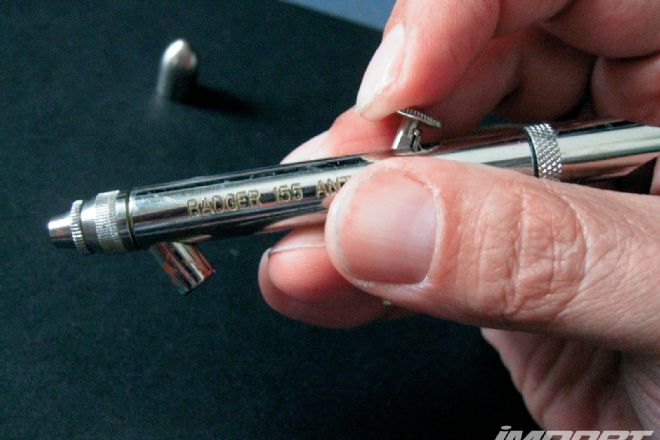Eric Hsu Facts:
1. Eric Hsu can stand on no feet.
2. If you Google Eric Hsu, you'll break the Internet.
3. Eric Hsu can sit in a race car, and by pulling up on the sides of its driver's seat, lift it into the air.
4. Eric Hsu can turn left on red. There is nothing anyone can do about it.
5. The cars Eric tunes don't run on any particular race fuel. They run on pure fear.
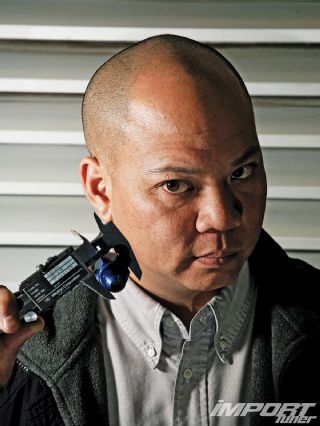 |
Eric Hsu
|
Eric Hsuwww.beyondthedyno.com/blogs/eric
Got a good tech question? Send it to Eric. Got one as bad as our Eric Hsu facts? Mark it "Anonymous."
questionit@importtuner.com
Old School Upgrade
I've been playing around with an '86 Nissan 300ZX for a couple of years now. I'm currently deployed in Afghanistan and am saving money for a move to the Philippines when I get out of the service next summer, but before I move, I would like to get some performance parts for my Z so I can send the parts and personal items all together. I'm not quite sure what direction I should take with the vehicle build or what parts to get for it. I have the budget and was thinking of purchasing an RB26DETT engine. I've seen previous owners swap these engines into the 300ZX and thought it would make a great upgrade. The RB-swapped cars I've witnessed had transmissions attached to them, but I wasn't sure if I could get the factory Skyline AWD setup to work on the car. Should I go with a different transmission altogether? I was also thinking of using a dry sump oil system for the engine, since they seem like a very good investment for performance.
-John A.
Via Importtuner.com
The '86 Z31 is my favorite year chassis because they still retain the original taillights before the model change, but have the wider fenders. One thing you may not know is that the '86 Z31 can also fit an aggressive wheel fitment in the rear with massive lips for potentially the meanest looking Z31 one can build. As far as the direction of the build goes, it really depends on how much you like the car and if you're willing to drop 5-6 times more cash than the car is actually worth. If you only like the car slightly, you might be better off buying another car that already has more power, looks a little more modern, and has better reliability. The RB26 engine drops right into the chassis with the Japanese RB20DET engine mounts. The RB26 is a long, iron engine, so the car will loose some of its chassis balance when compared to the original VG30DE V-6, which is almost half as long. The transmission to use will come from an RB20DET Z31, HCR32 Skyline, or ECR33 Skyline. These Skylines are rear-wheel drive so they will bolt right up to the RB26 with a transmission mount and driveshaft from the RB20DET Z31. Of course, you'll have to deal with custom wiring and run an RB26DETT ECU. Dry-sump oiling is certainly an option, but does require extensive amounts of custom plumbing. If you're planning on serious road or drag racing, a dry sump is definitely a good way to go. Hi-Octane Racing in Sydney, Australia has a complete bolt-on kit, but it is designed for the Skyline GT-Rs, although the system could work for your application with some modifications. And a lot of $$.
Painting for Performance
I own a '92 240SX with an SR20DET and a front-mount intercooler (FMIC). I've been contemplating using black radiator paint to provide a more stealthy appearance to my intercooler. Does radiator paint on an intercooler help dissipate heat, or would it inhibit heat transfer? If painting helps, why don't we see it more often?
-James Russell
Via Importtuner.com
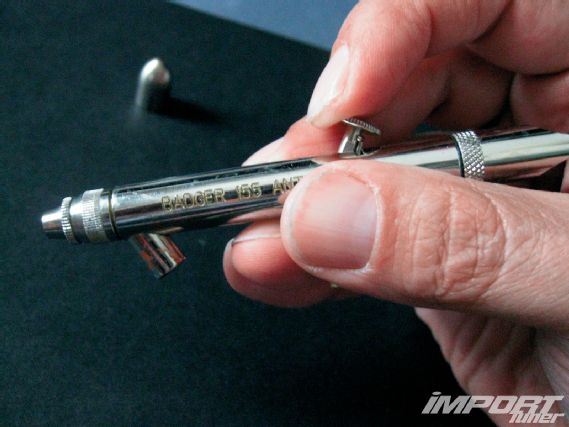 |
Old School Upgrade, Paint Performance and More - Question It
|
Old School Upgrade, Paint Performance and More - Question It
I asked a hardcore physicist buddy and he said that you could waste weeks of time comparing the amount of heat emissivity coming off a part with a painted surfaces of various colors versus unpainted surfaces of various finishes, while viewing the results in the infrared light spectrum. He thinks you would probably find that the painted surface could potentially retain more heat depending on the type of paint, the finish of the paint, and the thickness of paint application. If any paint had a chance of working well, it might be flat black. It's kind of an engineer's wives tale that black conducts the most heat, and when viewed under a microscope, flat paints actually have the most surface area to do so. For maximum cooling, we came to the conclusion that you'd probably be best off with a raw aluminum surface that has been sand blasted for even more surface area (but would be more susceptible to stains due to the porosity of the surface), or-if you need to have that dark finish-an anodized black core. Overall, it's a grey area and I've never personally done any testing myself. My buddy believes there wouldn't be massive differences between painted surfaces of any specific color or various unpainted surfaces, unless the paint was specifically designed to retain heat (which isn't what you want). Instead of all this grey-area stuff that would take a whole lot of testing before coming to any kind of conclusion, why not purchase a high-quality intercooler core that performs at a superior level to begin with? After all, if you polish (or paint) a piece of crap, you still have a piece of crap.
Riding on Rails
I drive a '98 Integra GSR with the factory front upper strut bar. I notice a lot of people in magazines and forums upgrade to more expensive, three-point bars and even the Type R strut bar. Is there any real benefit over the factory one, or is it mostly for show? I autocross and plan to road race in the near future and would like to increase my car's handling.
-Jamaul
Via Importtuner.com
Depending on how the three-point bar is anchored to the chassis, it could be effective or just for looks. If the third-point is anchored on the firewall but there's only a single layer of sheet metal securing the unit, it's highly unlikely that it's going to do anything but looking extra ricey. If the third-point bolts to a section of the firewall where there are multiple layers of steel that are spot welded together, then the third point might improve chassis stiffening to some degree. The factory GSR strut bar is pretty much a thin steel tube welded to stamped steel end pieces, which is probably better than nothing. The Type R bar has machined and welded ends that bolt to the strut towers and an extruded multi-section aluminum bar. I'd go for the Type R bar given the choice, since its construction appears to make the car stiffer and more effective than the factory GSR unit.
Quick Fix
I drive a '92 Integra GSR, and I just ran into a bit of a problem after rebuilding the engine: The threads for the timing belt tensioner bolt hole are stripped. I was thinking about using a heli-coil and some thread lock to fix the problem. Will this hold or will I have to look into some other fix?
-Josh, Lathrop
Via Importtuner.com
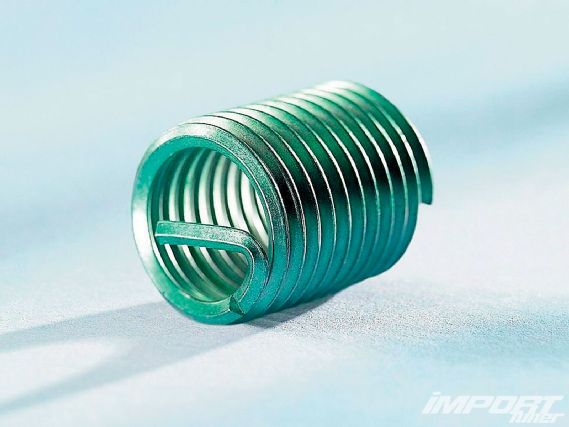 |
Old School Upgrade, Paint Performance and More - Question It
|
Old School Upgrade, Paint Performance and More - Question It
Heli-coils are probably the best way to fix your threads and the good news is they're offered in many of the common threads found on Hondas, such as M6x1.0, M8x1.25, M10x1.25, M12x1.25, etc., and the inserts are offered in 1.0, 1.5, 2.0, 2.5, and 3x bolt diameters. The bad news is there isn't a whole lot of room between the frame rail/shock tower assembly and the tensioner bolt, so you may have to lower the engine assembly to perform the repairs. I recommend using Permatex or Loctite 242 "blue" for the job, since this is a bolt designed to be removed and installed with hand tools, and needs to be torqued to only 40 ft-lbs.
Horsepower Hungry
I recently purchased a '94 Honda Del Sol with a D-series engine (not sure which one) that has a lot of mods, including a T04E turbo, custom billet aluminum FMIC, Tial 38mm wastegate, TurboXS blow-off valve, TurboXS boost controller, and a Tanabe exhaust. The engine makes good horsepower but I would really like to get more out of it by doing some internal modification like headwork, cams, and rods, but I'm really having a hard time finding the parts. My target goal is to make 420 hp and I am not concerned with the cost or time that would be involved with this build. Any recommendations or ideas of what I should do would be greatly appreciated.
-Jamie Garra
Via Importtuner.com
Contact the guys over at Bisimoto Engineering who have extensive experience with single-cam Honda engines and probably have all the parts you're looking for, such as cylinder heads, cams, valvetrain, etc. As for pistons and rods, you can try companies like JE, CP, BC, and Arias for components, or the guys over at Bisimoto may have their own custom design. You should contact your local tuner and see what ECU and fuel system components they recommend. Or if you're willing to handle the tuning yourself, contact the guys over at Hondata for an ECU solution.
Legal Shipment
I recently moved to CA from New Zealand and sadly left my SR20DET-powered '77 Toyota Corolla KE30 behind. I want to bring it stateside but keep hitting dead-ends when addressing the legality of my engine. I'm aware that the SR is illegal over here, but heard a rumor that since my car is older than 25 years it may be exempt. My question is, is there any way I can get it here with that engine? Or would my best option be to put a different engine in, perhaps a rotary? Also, would I have to convert it to left-hand drive? Thanks for your time. I hope I can finally get my baby here!
-Marc
Via Importtuner.com
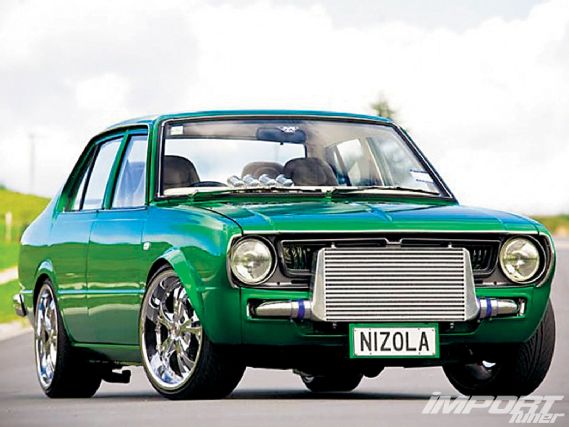 |
Old School Upgrade, Paint Performance and More - Question It
|
Old School Upgrade, Paint Performance and More - Question It
When it comes to engines, it had to have been certified by the EPA, or manufactured before emissions standards started to apply (1973) to have a chance of being legal in the U.S. Assuming the engine has EPA certification, for your car to be legal, the car needs to be in an unmodified state with the original engine, ECU, engine harness, and all the emissions devices and sensors that came with that year engine as well. Taking a look at your car-which is pretty damn nice by the way-my guess is that it will have no chance in hell of ever getting into the U.S. legally, as a street car. First and foremost because the SR20DET was never an EPA-certified engine in the U.S., second because an SR20DET was not manufactured before '73, and even using the 21-year car exemption, your car is most definitely not in an unmodified state. That's a shame because it's a damn nice car! For a complete document on vehicle importation, visit the EPA's website and download a .pdf document at www.epa.gov/OMS/imports/420b10027.pdf, or get in contact with the Specialty Equipment Market Association (SEMA)'s SEMA Action Network (SAN): www.semasan.com

